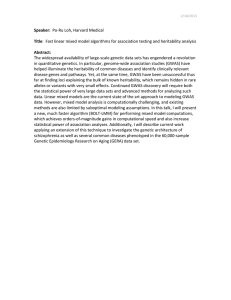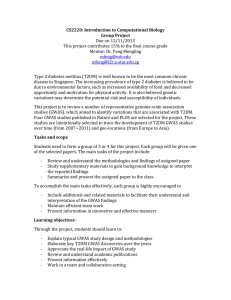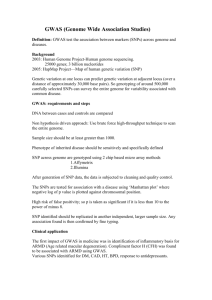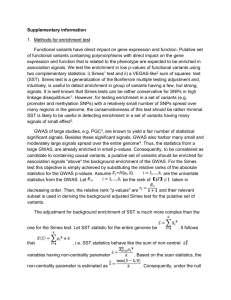news and views infectious diseases not immune to genome-wide association
advertisement
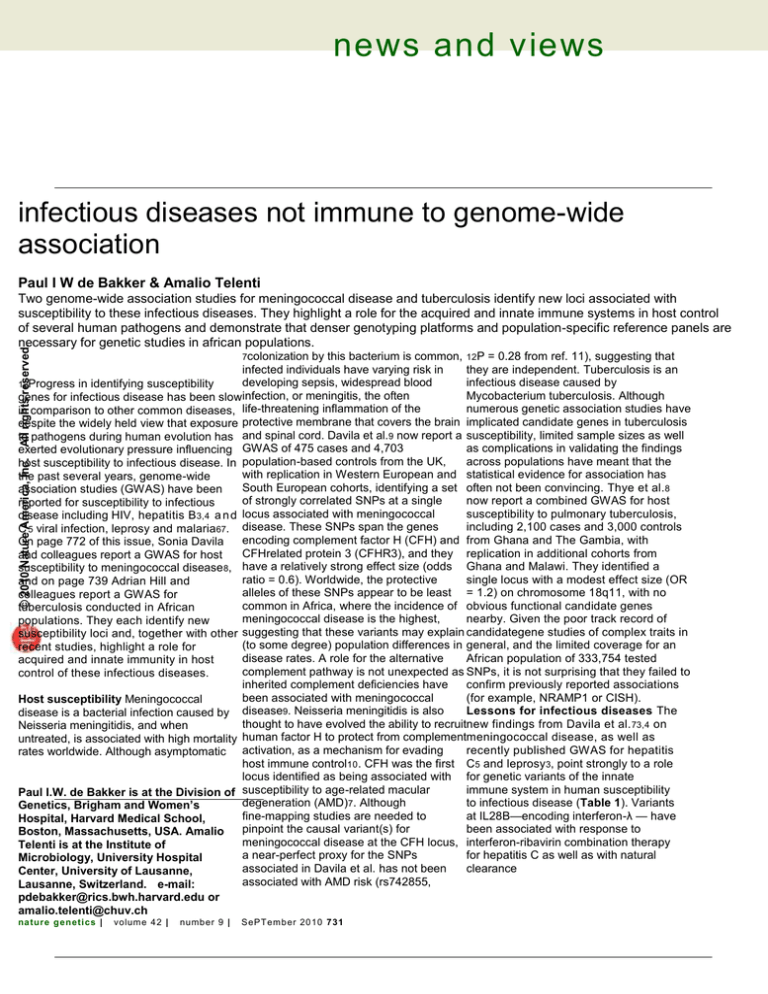
news and views infectious diseases not immune to genome-wide association Paul I W de Bakker & Amalio Telenti © 2010 Nature America, Inc. All rights reserved. Two genome-wide association studies for meningococcal disease and tuberculosis identify new loci associated with susceptibility to these infectious diseases. They highlight a role for the acquired and innate immune systems in host control of several human pathogens and demonstrate that denser genotyping platforms and population-specific reference panels are necessary for genetic studies in african populations. by this bacterium is common, 12P = 0.28 from ref. 11), suggesting that infected individuals have varying risk in they are independent. Tuberculosis is an developing sepsis, widespread blood infectious disease caused by 12Progress in identifying susceptibility Mycobacterium tuberculosis. Although genes for infectious disease has been slowinfection, or meningitis, the often numerous genetic association studies have in comparison to other common diseases, life-threatening inflammation of the despite the widely held view that exposure protective membrane that covers the brain implicated candidate genes in tuberculosis to pathogens during human evolution has and spinal cord. Davila et al.9 now report a susceptibility, limited sample sizes as well as complications in validating the findings exerted evolutionary pressure influencing GWAS of 475 cases and 4,703 across populations have meant that the host susceptibility to infectious disease. In population-based controls from the UK, with replication in Western European and statistical evidence for association has the past several years, genome-wide South European cohorts, identifying a set often not been convincing. Thye et al. 8 association studies (GWAS) have been of strongly correlated SNPs at a single now report a combined GWAS for host reported for susceptibility to infectious susceptibility to pulmonary tuberculosis, disease including HIV, hepatitis B 3,4 a n d locus associated with meningococcal including 2,100 cases and 3,000 controls C 5 viral infection, leprosy and malaria67. disease. These SNPs span the genes encoding complement factor H (CFH) and from Ghana and The Gambia, with On page 772 of this issue, Sonia Davila CFHrelated protein 3 (CFHR3), and they replication in additional cohorts from and colleagues report a GWAS for host susceptibility to meningococcal disease 8, have a relatively strong effect size (odds Ghana and Malawi. They identified a ratio = 0.6). Worldwide, the protective single locus with a modest effect size (OR and on page 739 Adrian Hill and alleles of these SNPs appear to be least = 1.2) on chromosome 18q11, with no colleagues report a GWAS for common in Africa, where the incidence of obvious functional candidate genes tuberculosis conducted in African meningococcal disease is the highest, nearby. Given the poor track record of populations. They each identify new susceptibility loci and, together with other suggesting that these variants may explain candidategene studies of complex traits in (to some degree) population differences in general, and the limited coverage for an recent studies, highlight a role for disease rates. A role for the alternative African population of 333,754 tested acquired and innate immunity in host complement pathway is not unexpected as SNPs, it is not surprising that they failed to control of these infectious diseases. inherited complement deficiencies have confirm previously reported associations been associated with meningococcal (for example, NRAMP1 or CISH). Host susceptibility Meningococcal Lessons for infectious diseases The disease is a bacterial infection caused by disease9. Neisseria meningitidis is also thought to have evolved the ability to recruitnew findings from Davila et al. 73,4 on Neisseria meningitidis, and when untreated, is associated with high mortality human factor H to protect from complementmeningococcal disease, as well as recently published GWAS for hepatitis rates worldwide. Although asymptomatic activation, as a mechanism for evading host immune control10 . CFH was the first C5 and leprosy 3, point strongly to a role locus identified as being associated with for genetic variants of the innate immune system in human susceptibility Paul I.W. de Bakker is at the Division of susceptibility to age-related macular to infectious disease (Table 1). Variants degeneration (AMD)7. Although Genetics, Brigham and Women’s fine-mapping studies are needed to at IL28B—encoding interferon-λ — have Hospital, Harvard Medical School, pinpoint the causal variant(s) for been associated with response to Boston, Massachusetts, USA. Amalio meningococcal disease at the CFH locus, interferon-ribavirin combination therapy Telenti is at the Institute of a near-perfect proxy for the SNPs for hepatitis C as well as with natural Microbiology, University Hospital associated in Davila et al. has not been clearance Center, University of Lausanne, associated with AMD risk (rs742855, Lausanne, Switzerland. e-mail: pdebakker@rics.bwh.harvard.edu or amalio.telenti@chuv.ch nature genetics | 7colonization volume 42 | number 9 | SePTember 2010 731 Hepatitis B2 Hepatitis B virus (HBV) Major histocompatibility complex, class II (HLA-DP) Hepatitis C virus (HCV) IL28B Innate immunity LeprosyMycobacterium leprae Major histocompatibility complex, class II (HLA- DR–DQ), NOD2, TNFSF15, RIPK2, CCDC122 and C13orf31) Hepatitis C3,4 5 Acquired and innate Ac The 1000 Genomes Project is well immunity, and unknown underway building a resource to mechanisms document all variants down to 1% frequency across the genome in 2,500 individuals sampled from >20 populations (including five from the African continent). With these new tools emerging, we should be better armed to conduct genetic association studies in non-European populations, which contain most of the global burden of infectious disease. platforms is also limited because of the added two African continental populations lesser extent of linkage disequilibrium (LD) (Luhya in Webuye from Kenya, and between variants in African populations. Maasai in Kinyawa from Kenya). For example, the SNPs on the Affymetrix 500K platform (used by Thye et al. 2) capture at most 46% of all SNPs in HapMap-YRI (Yoruba from Ibidan, Nigeria), with pairwise r > 0.8 (ref. 15). Moreover, imputation can only be Mycobacterium tuberculosis Tuberculosis8 7 66expected 13 1 and leprosy 8 5 8 to work well if the HapMap panel is adequately representative of the haplotype structure in the population samples studied. Indeed, Thye et al. noted that the quality of the imputations in their Ghanaian and Gambian samples was rather poor (with a mean imputation error of 8%) when they used HapMap-YRI as the reference panel and Affymetrix 500K SNPs from the GWAS as input genotypes. Although this is by no means a systematic evaluation of the problem, it is consistent with findings from a recent malaria GWAS, which found substantial population substructure in their samples from The Gambia. Jallow et al. - 7 identified a rather weak association signal for malaria susceptibility at the previously identified ß -hemoglobin gene HBB (P ˜ 10- 14). After sequencing this locus in a custom reference panel of 96 Gambians, they were able to impute and detect the sickle-cell hemoglobin causal amino acid change that is known to protect against malaria with much stronger statistical significance (P ˜ 10). These are compelling demonstrations that the genotyping platforms routinely used for GWAS in European populations do not provide sufficient coverage in African populations and that a more diverse set of reference panels are needed for effective imputations. HapMap Phase 3 has already Future MHC region, going that shows the highest studies The beyond the classicaldensity of associations to identification HLA genes. The complex diseases. A of variantscomplex nature of the complementary, in genes ofMHC region, with itshypothesis-driven approach the acquired broad LD, high would be to test specifically and innatediversity and the set of about 1,000 immunity in structural variation, genes that have been GWAS for makes it one of the characterized as involved infectious most difficult regionsin innate immunity. Another disease of the genome to challenge in identifying calls for a study, but doing so host susceptibility factors is systematicshould be a potential confounding by dissection worthwhile of effort, asthe it infecting strain, as most the entire is the genomic region studies do not take into Meningococcal disease 5, 10. Klein, R.J. et al. Science 308, 385–389 (2005). 11. Raychaudhuri, S. et al. Nat. Genet. 42, 553–555, author reply 555–556 (2010). 12. Möller, M., de Wit, E. & Hoal, E.G. FEMS Immunol. Med. Microbiol. 58, 3–26 (2010). 13. Barrett, J.C. et al. Nat. Genet. 40, 955–962 (2008). 14. Teo, Y.Y., 1. Fellay, J. et al. Science 317, 944–947 (2007). 2. Small, K.S. & Kwiatkowski, D.P. Nat. Rev. Kamatani, Y. et al. Nat. Genet. 41, 591–595 Genet. 11, 149–160 (2010). 15. The International (2009). 3. Ge, D. et al. Nature 461, 399–401 (2009). HapMap Consortium. Nature 449, 4. Rauch, A. et al. Gastroenterology 138, 1338–45, 851–861 (2007). 1345e1–e7 (2010). 5. Zhang, F.R. et al. N. Engl. J. Med. 361, 2609–2618 Neisseria meningitidis CFH, CFHR3, CFHR1 Innate immunity 5. In the case of 4of the leprosy 18q11.2 (GATA6, CTAGE1, RBBP8, CABLES1) a single GWAS identified several candidate susceptibility genes (NOD2, TNFSF15 and RIPK2), all encoding proteins involved in innate immune response. The apparent overlap between the hits for leprosy and Crohn’s disease might also motivate a more targeted analysis of all variants involved in autoimmunity, leveraging the recent wave of new loci associated with autoimmune disorders identified through GWAS. The human leukocyte antigen (HLA) region also has an important role in infectious diseases. GWAS have implicated variants of major histocompatibility (MHC) class I genes as having strong associations with effective control of HIV-1 replication2. A recent GWAS of chronic hepatitis B infection highlighted variants in HLA-DP, an MHC class II gene. There was no overlap of genetic signals between the GWAS for tuberculosis despite the various aspects of histopathology shared between the two diseases. However, Thye et al. did report a weak association in the MHC class II (HLA-DQ region) in tuberculosis 5, a region in which Zhang et al. also identified variants associated to leprosy. 14 African genetics With most of the GWAS reported over the past few years focusing on European populations, there remain technical challenges with genome-wide association analysis conducted in non-European populations15. Imputation based on linkage disequilibrium between genotyped markers and SNPs typed in a reference panel (such as HapMap) can improve coverage and power and has been a key tool for meta-analyses across different genotyping platforms. In African populations, the coverage of common variation in current 732 volume 42 | number 9 | SePTemb er 2010 | nature genetics (2009). 6. Jallow, M. et al. Nat. Genet. 41, 657–665 account the variability of the pathogen 7. Davila, S. et al. Nat. Genet. 42, 772–776 itself. Genetic studies for host susceptibility(2009). (2010). 8. Thye, T. et al. Nat. Genet. 42, 739–741 to infectious disease will need to (2010). 9. Serruto, D., Rappuoli, R., Scarselli, M., Gros, incorporate such considerations for a more P. & van Strijp, J.A. Nat. Rev. Microbiol. 8, 393–399 complete picture of how the pathogen (2010). evades host immune responses. Unknow n 8 virus COMPETING FINANCIAL INTERESTS The authors declare no competing financial interests.
